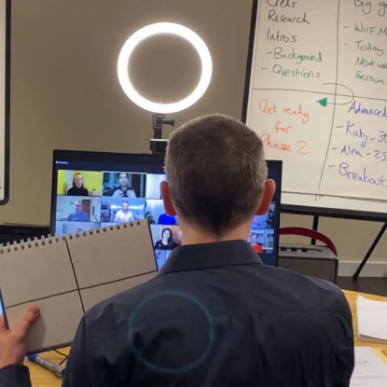“Stories can engage and shape our emotions. They have the power to make us care about information. When we are emotionally invested in a story, we are more likely to act on that story.“
How To Improve Your Storytelling Presentation Techniques To Engage An Audience
As human beings, the presentations that we engage with the most are ones which tell us stories. Telling great stories gives you the power to persuade, hook audiences in and elicit change.
You can engage more people with your message by improving your business storytelling within your presentations.
Why is storytelling important?
What do cave paintings have in common with social media? They are both designed to tell stories.
Storytelling has been part of human existence as far back as you can go. The first evidence of storytelling was cave paintings more than 65,000 years ago, communicating knowledge and important information before writing was even invented. From there we see oral histories spread across continents, the development of alphabets, the printing press, the internet and, most recently, social media – all to help us share stories.
It’s a deeply human trait. We are social creatures – stories have always been an effective way of transmitting information. Essentially, we experience life through the stories we hear and tell.
Stories are essential for sharing information, but they are also a key tool in influencing people’s feelings and conveying emotion. The power of storytelling offers businesses huge potential.
Here are five reasons why storytelling is so important:
1 – It brings clarity to your message
The Nobel-prize-winning economist Daniel Kahnemann famously said ‘Nobody ever made a decision based on a number – they need a story’.
It’s easy to put together a presentation based on facts and figures – but data itself has no meaning unless we construct it in the minds of our audience. When you have data to share, whether that’s statistics, financial updates, spreadsheets or graphs, finding the story behind that data will help your audience to understand why it’s important.
Take a spreadsheet, for example. On the face of it, it’s just a bunch of numbers, written in black and white, with no inherent meaning. The meaning comes from the stories within it. For example, every number on that spreadsheet represents something which happened, something that someone did, a cause and effect. There was a human decision or action that made those numbers happen. Tell that story to your audience to help them understand what your data means.
2 – It helps us remember information more easily
If you want your audience to remember the information that you’re sharing, you need to package it within a story.
Numbers are abstract concepts, and for that reason, it’s very difficult to remember them. Throw in different forms of numbers, such as percentages and margins, and it becomes almost impossible.
Weaving numbers into a story helps your audience to remember them much more easily. By telling people the stories behind the data and encouraging them to feel something about the numbers, you’re more likely to make your content memorable beyond your meeting.
The imagination is very powerful. By using storytelling techniques to illustrate the meaning behind your numbers, through metaphors, imagery or real-life case studies, you can increase your audience’s power of recall and make your message stick.
3 – It helps achieve a deeper connection with your audience
Meaningful connections are made when we engage with people on an emotional level, and business storytelling allows us to do this.
Stories can engage and shape our emotions. They have the power to make us care about information. When we are emotionally invested in a story, we are more likely to act on that story, especially if we have been taken on a journey from a negative pain point to something positive and optimistic.
Essentially, encouraging your audience to feel something is going to help those meaningful connections to take root. Through good storytelling, you can make your audience care about you, your company, your product, your data, or the future.
4 – It elevates your brand and its value
If you are consistent with storytelling, you can give your brand more perceived value.
Through telling stories, you can help to establish credibility in the eyes of your audience. Telling passionate stories about what motivates you gives your audience the full picture of who you are and helps to build trust.
As Dr Pragya Agarwal, a behavioural scientist and TED X speaker writes,
“ I always ask my clients to start by figuring out their own ‘why’. What is the purpose of the brand? It is not just about making money. What kind of problem does it solve? What kind of social change does it bring about? Communicating this purpose through your tagline and your brand story creates trust and a connection with customers. It creates a reason for them to buy from you.”
5 – It encourages problem-solving
Using a storytelling approach to sharing content can help you get to the heart of problems more quickly and dive beyond the surface to provide a richer source of answers.
This tactic was famously employed by Amazon’s Jeff Bezos in 2004, who outlawed the traditional PowerPoint presentation during team meetings and, instead, instructs his teams to prepare six-page narrative memos based on telling a compelling story, rather than lists or bullet points.
Then, at the start of team meetings, staff are given 20 minutes to read the memo. They have time to consider and think more critically about the content, which leads to more meaningful discussions, with better results, more creative ideas and wide-ranging perspectives.
Journalists work in the same way. To get to the real heart of a story, they’ll seek to answer the who, what, why, where, when and how of that information. Asking better questions through storytelling will ultimately lead to better answers, and will help you to find better solutions to challenges.
Is there a science for storytelling?
Yes… and no.
There are many great storytelling experts, such as Robert McKee, who have written extensively about the science of storytelling, and specific techniques that you can use to make your content more compelling.
Studies have shown that good storytelling elicits a chemical reaction within the brain and causes it to release oxytocin; a hormone that helps us to feel empathy. By telling great stories, you can make your audience understand you, support you and ultimately be persuaded by you.
Here are some techniques that you can use to bring storytelling into your business presentations:
Narrative vs storytelling
For example, McKee outlines the importance of understanding the difference between narrative and storytelling:
“The narrative is chronological, descriptive, and process-driven — “I started this company. We designed the best product. You should buy it. That’s all you need to know.” But in storytelling, you need a compelling journey — this means you must acknowledge negatives as well as positives.”
Watch any episode of Dragon’s Den or Shark Tank and you’ll see successful entrepreneurs tell the stories behind their products: personal stories about themselves, their successes and failures which help to make those emotional connections with their audience.
Tension and triumph
One of the most compelling storytelling devices is tension, and this can be stoked by outlining problems or challenges that affect or resonate with your audience, before offering a solution or better future outcome.
When tension is built within a story, we naturally want to stick with that story to the end in the hope of a positive conclusion.
When audiences are emotionally hooked to your story, they are more likely to pay attention throughout your presentation, and then take action on your message at the end.
Make it personal
As human beings, stories about people resonate with us much more strongly than dry data and statistics. So if you want to tell a compelling story, make it personal.
It may be a story about you or one of your team and the adversities you’ve had to overcome; it could be a case study about a client or service user and what your business has done for them. Journalists often call these ‘human interest’ stories – because they resonate with us more deeply than dry data or updates.
By making stories personal, you’ll bring them to life in your audience’s imagination.
Bring numbers to life
As we’ve seen already, humans struggle with numbers due to their abstract nature – and big numbers are very difficult to understand.
So when you’re using big numbers, make them tangible. If you’re talking about your weekly reach on social media hitting 50,000 people, you can make this concept more tangible by saying “that’s the equivalent of a football stadium full of people”. The more descriptive you can be, the more you’ll fire up your audience’s imagination and the more engaged they will be in your message.
“Think of just how many people fit into a football stadium. Think of the roar of the noise, the people filing in from outside, gradually taking their seats until the stadium is full and you can feel the excitement and energy.”
Suddenly, those numbers have come to life.
Ditch bullet points in favour of images
People can’t read and listen at the same time, so if you’ve put the effort into coming up with a great story to illustrate your content, don’t ruin it with bullet points in slides.
When we read text, we tend to ‘subvocalise’; that is, we silently read the words in our own head, drowning out the sound of anything the speaker may be saying. It’s a sure-fire way for your audience to switch off from your message.
If you want to bring your stories to life, use bold, compelling images or photos. Minimise any text on slides – or, if you’re feeling brave, ditch it altogether.
The Art of Storytelling
While there is a science to storytelling, there’s also an art to it. Part of that art is about finding your story.
Robert McKee says that true originality in storytelling is the ‘meeting of form and content’.
“A writer in pursuit of a masterfully told story must understand that storytelling techniques are irrelevant if they don’t also have rich content that this form will express.
A masterful story is predicated on the author’s insight into human nature. You must develop a God-like knowledge of your content, the characters, their history, and the world in which they live. Great storytelling goes beyond technique; it also requires you have something to say.”
Who benefits from business storytelling training?
Wherever you are in your career, you can benefit from storytelling training. You can improve your business storytelling presentations in as little as 20 minutes!
Storytelling training can help give you the tools to figure out what your business’s story is, and what is going to resonate most with your audience. It can help you to make sense of data and statistics so that you can tell the right story to your audience to engage with them emotionally and get them invested in you, your business or your product.
As you begin to unravel your story, training can help you make sure that you make it as compelling as possible so that more people will take action on your message.
Get in touch
Body Talk has been providing business storytelling coaching for over two decades. If you’d like to find out how storytelling could benefit your business, get in touch with us today.
The BodyTalk Podcast – Tips From The Master Of Storytelling Robert McKee from Body Talk on Vimeo.




















